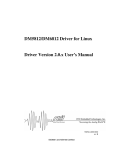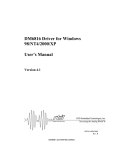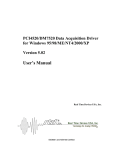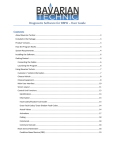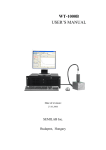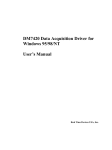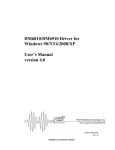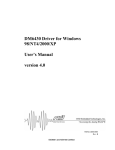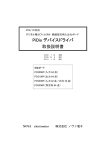Download DM6812/DM6912 Driver for Windows 98/NT/2000/XP User`s Manual
Transcript
DM6812/DM6912 Driver for Windows 98/NT/2000/XP User’s Manual version 4.1 SWM-640010006 Rev. B ISO9001 and AS9100 Certified RTD Embedded Technologies, INC. 103 Innovation Blvd. State College, PA 16803-0906 Phone: +1-814-234-8087 FAX: +1-814-234-5218 E-mail [email protected] [email protected] web site http://www.rtd.com DM6812/DM6912 Driver for Windows 98/NT/2000/XP ii Revision History 08/06/2003 revision A issued 09/24/2003 Revision B issued Version 4.1 released Company name changed Windows 95 support removed All function and files names *6812 changed to *6812 DM6812/DM6912 Driver for Windows 98/NT/2000/XP Published by: RTD Embedded Technologies, Inc. 103 Innovation Blvd. State College, PA 16803-0906 Copyright 2003 RTD Embedded Technologies, Inc. All rights reserved Printed in U.S.A. The RTD Logo is a registered trademark of RTD Embedded Technologies. cpuModule and utilityModule are trademarks of RTD Embedded Technologies. PS/2, PC/XT, PC/AT and IBM are trademarks of International Business Machines Inc. MS-DOS, Windows, Windows 98, Windows NT, Windows 2000 and Windows XP are trademarks of Microsoft Corp. PC/104 is a registered trademark of PC/104 Consortium. All other trademarks appearing in this document are the property of their respective owners. iii DM6812/DM6912 Driver for Windows 98/NT/2000/XP Table of Contents TABLE OF CONTENTS ..............................................................................................................4 INTRODUCTION .........................................................................................................................5 INSTALLATION ..........................................................................................................................6 INSTALLATION OF THE DRIVER AND EXAMPLE PROGRAMS ..........................................................6 THE DM6812 BOARD DRIVER.......................................................................................................7 THE DRIVER CONFIGURATION ......................................................................................................7 INSTALLING A NEXT DM6812 BOARD IN THE SYSTEM ..................................................................8 WORKING WITH OTHER BOARDS USING THE WINRT DRIVER .....................................................8 USING WINDOWS REGISTRY KEYS ................................................................................................9 THE DRIVER API FUNCTIONS .............................................................................................11 USING THE DRIVER WITHOUT THE WINDOWS-GUI ...................................................12 DRIVER API FUNCTION GROUPS .......................................................................................13 DRIVER INITIALIZATION FUNCTIONS ..........................................................................................13 GENERAL BOARD CONTROL FUNCTIONS ....................................................................................13 DIGITAL I/O FUNCTIONS ............................................................................................................13 INTERRUPT HANDLING ...............................................................................................................13 USER TIMER-COUNTER FUNCTIONS ...........................................................................................13 ERROR HANDLING FUNCTIONS ...................................................................................................13 ALPHABETICAL DRIVER API FUNCTIONS REFERENCE ............................................14 EXAMPLE PROGRAMS REFERENCE .................................................................................26 WIN32 WINDOWS APPLICATIONS ...............................................................................................26 LIMITED WARRANTY ............................................................................................................27 DM6812/DM6912 Driver for Windows 98/NT/2000/XP iv Introduction The DM6812 Windows 98/NT4/2000/XP driver was designed for programmers who write Windows-based application programs with using the RTD’s DM6812 board or DM6912 board. DM6812 and DM6912 are the same boards with different interface connector. Later we will refer both boards as DM6812. The driver provides an Application Programming Interface with a lot of function calls to perform all the data acquisition tasks of the board users. The board driver based on the BlueWater System's WinRT device driver kit. There are example programs to demonstrate the various board features and the usage of the driver API. The example programs are written in Microsoft Visual C++ ver. 6.0. Installation Installation of the Driver and Example Programs Before installing the driver and example program files, you need to install the DM6812 board in your PC. Please follow the instructions of the manufacturer, how to install the board in a computer. To install the drivers for the DM6812 under Windows 98/2000/XP you need the installation diskette 0. The readme.txt file on this diskette describes the necessary installation steps. For NT4 the installation diskette 0 is not needed. On the installation diskette 1 you can found the Setup.exe program, which installs on your PC the DM6812 board driver and example programs. The setup program automatically detects your operating system and installs the appropriate files on your PC. After starting the setup, please follow the instructions on the screen to install the programs. You can select the directory where to install the files. The setup also adds to the ‘Start menu’ under the ‘Programs’ folder of your Windows system the ‘RTD Embedded Technologies’ folder. It contains shortcuts to the example programs, the driver configuration utility and the readme.txt file. The example programs will be installed in the target directory under the ‘Examples’ folder. This folder contains the example program sources for the DM6812 board, and the project files for Microsoft Visual C++ users to rebuild the programs. The example programs are compiled with the Microsoft Visual C++ ver. 6.0. In case of different version of Visual C is installed on your PC, please rebuild the executable files. Uninstallation: you can uninstall the DM6812 driver and example programs under the ‘Control panel’ with the ‘Add/Remove Programs’ tool. DM6812/DM6912 Driver for Windows 98/NT/2000/XP 6 The DM6812 board driver The RTD's DM6812 board driver handles the hardware through the BlueWater’s WinRT driver. The WinRT driver provides the low-level access to the board, and the RTD's drvr6812.dll provides the device API for the programmers, and communicates with the hardware through the WinRT driver. The RTD board drivers has multi-board feature. It means that it is possible to use more than one board in the system. The base address of the DM6812 board can be set by DIP-switch. If you are using multiple boards in your system, you need assign a different base address to each board. The IRQ channel will be set programmatically. When you install the driver for the board, the installation program sets up a default IRQ channel, and during the operating of the board must be used this IRQ number. Each board requires a unique WinRT device to handle the hardware. The maximum number of devices is 32. The installation program creates the wrtdev.txt file in your ‘Examples’ directory. It contains the WinRT device number used with the installed board. The example programs are starting with reading of this file to obtain the proper device number. During the installation the Setup.exe program set the default driver values: Board 1: 0x300 base address, IRQ 0x11 If these settings are not proper to your PC configuration, you can modify the settings with the Drvr_cfg.exe program. The Driver Configuration As in the previous chapter mentioned, after installing the driver the default settings are used. If these settings are not proper to your PC configuration, or there are other RTD boards used, you can modify the settings. Under Windows NT driver can be configured with the Drvr_cfg.exe program. This program is installed on your PC during the setup process and it can be started from the Start menu. Program options: - Device number: The number of device, which handles the board. Each board has a unique device number between and 0-31. - I/O port base address: The I/O base address of the board. - IRQ number: The IRQ number using of the board. - Register: Press this button to store the settings in the Windows registry. Refresh: Press this button to get the information from the registry about the selected device number. Under Windows 98/2000/XP same changes can Panel/System/[Hardware]/Device Manager/WinRT Devices. be made using Control Do not forget, that all boards are required different driver devices, and in your C++ program the DEVICE_NO must be used according to the driver device number. 7 DM6812/DM6912 Driver for Windows 98/NT/2000/XP Installing a next DM6812 board in the system It is possible to use more than one board in the system using the RTD’s data acquisition board drivers. Please follow the next steps to install a multi-board – system: - - Install the first board with all software and make sure that everything is working well. Place the second board in an empty slot in the PC, and switch on the computer. Windows NT4: After the system startup start the installation program and answer ‘YES’ to the next board installation question. Restarting the system with the two-board example program is possible to test the working of both boards. Please note that during the second board installation the driver and example program files will be refreshed thus you need to save the important changes before starting the install. Windows 98/ME/2000/XP: You need only the installation diskette 0 to install the next boards. Follow the steps described in the readme.txt file on diskette 0. Working with Other Boards Using the WinRT Driver As you may have in your computer other RTD boards, which uses the WinRT driver, or a board from other manufacturer with WinRT, our installation program automatically detects the WinRT settings from the system registry file, and installs the appropriate (next) WinRT device. You can see an informational dialog box about this issue during the setup. As an application written for the DM6812 board should know which WinRT device is assigned to the board, the installation program generates the file wrtdev.txt in the ‘Examples’ directory containing the actual device number. The example programs are reading this file at the startup to identify this number. If the other board in your system, which uses the WinRT driver does not handle the situation when there is other WinRT-based application, install this board firstly, and then install the DM6812 which handles correctly this state. DM6812/DM6912 Driver for Windows 98/NT/2000/XP 8 Using Windows registry keys The RTD board drivers are using the next registry keys: Windows NT 4.0: HKEY_LOCAL_MACHINE | | -- System | | -- CurrentControlSet | | -- Services | | -- WinRT | | -- WinRTdev0 (one per device) | | | | -- Parameters | | | | -- Section0 | -- WinRTdev1 | | | | -- Parameters | | | | -- Section0 | Windows 98 Enum key path: HKEY_LOCAL_MACHINE | | -- Enum Windows 98 Class key path: HKEY_LOCAL_MACHINE | | -- System | | -- CurrentControlSet | | -- Services | | -- Class | | -- WinRTDevices 9 DM6812/DM6912 Driver for Windows 98/NT/2000/XP Windows 2000/XP device class information: HKEY_LOCAL_MACHINE | | -- System | | -- CurrentControlSet | | -- Control | | -- Class | | -- {D695ED6A-630D-4D83-D8B-F1F0AC107AD0} | | -- 0001 Windows 2000/XP Plug and Play devices are enumerated under the Enum key: HKEY_LOCAL_MACHINE | | -- System | | -- CurrentControlSet | | -- Enum | | -- PCI DM6812/DM6912 Driver for Windows 98/NT/2000/XP 10 The Driver API Functions The resources on the DM6812 board can be accessed from Windows through the driver API (Application Programming Interface) functions. The executable code of these functions is located in the drvr6812.dll file. To write applications using the API functions you must include the reg6812.h header file, and link the program with the drvr6812.lib import library file. In the example programs you can find different examples how to use the driver. 11 DM6812/DM6912 Driver for Windows 98/NT/2000/XP Using the Driver without the Windows-GUI This driver is based on the Win32 system, and can run only under Windows. However, the user, who is not familiar with the Windows Graphical User Interface, can use the driver API functions in Win32 console applications, which has an MS-DOS like text-mode interface. In console applications is not necessary to use the Windows graphical environment, but all the driver’s API functions are accessible. The Microsoft Visual C++ compiler supports writing console applications. DM6812/DM6912 Driver for Windows 98/NT/2000/XP 12 Driver API Function Groups Driver Initialization Functions OpenBoard6812 CloseBoard6812 General Board Control Functions InitBoard6812 Digital I/O Functions ReadDIO6812 WriteDIO6812 SelectDIOClock6812 LoadDIOBitDir6812 LoadDIOPortDir6812 LoadDIOComp6812 LoadDIOMask6812 Interrupt Handling ClearBoardIRQ6812 ClearDIOChip6812 ClearDIOIrq6812 EnableBoardIRQ6812 IRQSharing6812 InstallCallbackIRQHandler6812 InstallCounterIRQHandler6812 RemoveIRQHandler6812 GetIRQCounter6812 IrqStatus6812 SetIRQPolarity6812 EnableDIOIrq6812 SetDIOIrqMode6812 User Timer-Counter Functions ClockDivisor6812 ClockMode6812 DoneTimer6812 InitTimer6812 isClockDone6812 ReadClock6812 Error Handling Functions GetErrorStatus6812 13 DM6812/DM6912 Driver for Windows 98/NT/2000/XP Alphabetical Driver API Functions Reference C ClearBoardIRQ6812 Description: This routine is used to clear the P14 IRQ circuitry. Parameters: hBoard: device handle ClearDIOChip6812 Description: This routine clears the selected DIO chip. Parameters: hBoard: Chip: device handle 0, 1, 2 (selects which DIO chip on board) ClearDIOIRQ6812 Description: This routine clears the selected DIO chips IRQ status bit. Parameters: hBoard: AIOChip: device handle 0, 1, 2 (selects which DIO chip on board) ClockDivisor6812 Description: The ClockDivisor procedure is used to set the divisor of a designated counter on the 8254 programmable interval timer (PIT). This procedure assumes that the counter has already been set to receive the least significant byte (LSB) of the divisor followed by the most significant byte (MSB). Parameters: hBoard: ATimer: ADivisor: device handle 0,1,2 divisor DM6812/DM6912 Driver for Windows 98/NT/2000/XP 14 ClockMode6812 Description: The ClockMode procedure is used to set the mode of a designated counter on the 8254 programmable interval timer (PIT). Parameters: hBoard: ATimer: AMode: device handle 0,1,2 0,1,2,3,4,5 CloseBoard6812 Description: This routine is used to close board driver. Parameters: DeviceNumber: WinRT device number to load szBuf: message buffer Return value: TRUE on success, FALSE on error 15 DM6812/DM6912 Driver for Windows 98/NT/2000/XP D DoneTimer6812 Description: Shut down timer operation initiated by 'InitTimer'. Parameters: hBoard: device handle DM6812/DM6912 Driver for Windows 98/NT/2000/XP 16 E EnableBoardIRQ6812 Description: This routine enables/disables the board P14 IRQ. Parameters: hBoard: AEnable: device handle 0 = disable 1 = enable EnableDIOIRQ6812 Description: This routine enables the selected DIO chips interrupt. Parameters: hBoard: AIOChip: AEnable: 17 device handle 0, 1, 2 (selects which DIO chip on board) 0 = Disabled 1 = Enabled DM6812/DM6912 Driver for Windows 98/NT/2000/XP G GetErrorStatus6812 Description: This routine is used to get the error code and string in case of errors. The function clears the last error code. Parameters: hBoard: ErrorCode: ErrorString: device handle Error Code Return error string Return Value: TRUE if error occurred FALSE otherwise GetIRQCounter6812 Description: This routine is used to get the counter incremented by IRQ. Parameters: hBoard: irqsetup: device handle return parameters to caller DM6812/DM6912 Driver for Windows 98/NT/2000/XP 18 I InitBoard6812 Description: This routine should always be called first. This clears the board and variables the driver uses. Parameters: hBoard: device handle InitTimer6812 Description: The InitTimer function is used to set the user clock to generate the designated output rate. The order of programming the timers are important to ensure loading the timers fast enough. The maximum attainable rate this function, as written, is 1000 Hz although you can easily change this by adjusting the divisors accordingly. Parameters: hBoard: ARate: device handle rate Return value: TRUE on success, FALSE on error InstallCallbackIRQHandler6812 Description: This routine is used to install IRQ handler function. Parameters: hBoard: isrT handler: device handle user callback function Return value: TRUE on success, FALSE on error InstallCounterIRQHandler6812 This routine is used to install IRQ handler function. Parameters: hBoard: 19 device handle DM6812/DM6912 Driver for Windows 98/NT/2000/XP irqsetup: return parameters to caller Return value: TRUE on success, FALSE on error IrqSharing6812 Description: This routine enables and disables the interrupt sharing feature of the board. Parameters: hBoard: AEnable: device handle 0 = Disabled 1 = Enabled IrqStatus6812 Description: This routine returns the IRQ status from the board. Parameters: hBoard: device handle Returns: the status register value isClockDone6812 Description: The isClockDone function returns TRUE if the designated counter on the 8254 programmable interval timer (PIT) has overflowed. The function uses the "counter latch command" to store the 16 bit counter register for the separated reading (low byte first, high byte next). The function stores the previous state of the counter register in the 'PrevClock' global variable, and returns TRUE, when the current counter register is larger than the previous one, i.e. the counter is loaded back. This ensures the recognition of the counter owerflow even of high clock rates. Parameters: hBoard: device handle Returns: TRUE / FALSE DM6812/DM6912 Driver for Windows 98/NT/2000/XP 20 L LoadDIOBitDir6812 Description: Load a Bit programable IOport. Ports 0,2,4 are Bit programable on the DM6812. Parameters: hBoard: AIOPort: Adir0-Adir7: device handle port 0-6 direction 0 = input 1 = output LoadDIOComp6812 Description: Load DIO compare register. Parameters: hBoard: AIOChip: AData: device handle chip 0-2 compare value LoadDIOMask6812 Description: Load DIO mask register. Parameters: hBoard: AIOChip: AData: device handle chip 0-2 mask bits LoadDIOPortDir6812 Description: Load a Port programable IOport. Ports 1,3,5 are Port programable on the DM6812. Parameters: hBoard: AIOPort: ADir: 21 device handle port 0-6 direction 0 = input 1 = output DM6812/DM6912 Driver for Windows 98/NT/2000/XP O OpenBoard6812 Description: This routine is used to open board driver. Parameters: DeviceNumber: LoadDevice: szBuf: BoardConfig: WinRT device number to load Indicate to load WinRT driver or not Message buffer Return board configuration Return value: TRUE on success, FALSE on error DM6812/DM6912 Driver for Windows 98/NT/2000/XP 22 R ReadClock6812 Description: Read the timer/counter count value. Parameters: hBoard: ATimer: device handle number of the Timer in the range of 0..2. Returns: 16-bit count value. ReadDIO6812 Description: The ReadDIO function returns the value of the specified digital input port. Each digital input line is represented by a bit of the return value. Digital in 0 is bit 0, digital in 1 is bit 1, and so on. Parameters: hBoard: AIOPort: device handle port 0 – 6 Returns: 8 bit unsigned character value RemoveIRQHandler6812 Description: This routine is used to uninstall IRQ handler function. Parameters: hBoard: 23 device handle DM6812/DM6912 Driver for Windows 98/NT/2000/XP S SetIRQPolarity6812 Description: This routine sets the P14 interrupt to use the positive edge or negative edge. Parameters: hBoard: Polarity: device handle 0 = positive edge 1 = negative edge SelectDIOClock6812 Description: Select digital sample clock. Parameters: hBoard: AIOChip: Clock: device handle 0, 1, 2 (selects which DIO chip on board) 0 = 8 MHz System 1 = Programmable clock SetDIOIrqMode6812 Description: Set digital IRQ mode. Parameters: hBoard: AIOChip: Amode: device handle chip 0 – 2 IRQ mode 0=EVENT 1=MATCH DM6812/DM6912 Driver for Windows 98/NT/2000/XP 24 W WriteDIO6812 Description: The WriteDIO function writes 'Data' to the specified digital output port. Parameters: hBoard: AIOPort: Data: 25 device handle port 0 - 6 0 - 255 DM6812/DM6912 Driver for Windows 98/NT/2000/XP Example Programs Reference Win32 Windows applications Name Digital Feature Sample program that demonstrates how to program digital I/O. Digital_IT Sample program that demonstrates how to use the P0.0 input as an interrupt source and how to write an Interrupt Service Routine (ISR). Interrupt Sample program that demonstrates how to use the timer as an interrupt source and how to write an Interrupt Service Routine (ISR). Match Sample program that demonstrates how to use the P0.0 input as match mode interrupt source. Timers Sample program that demonstrates how to program the user timer. Remarks Sample program that demonstrates how to read and write the digital I/O. The program sets Ports 0 and 1 as outputs. The rest of the ports are set as inputs. The program constantly displays the value of the lines on the input port in the center of the screen. You can enter a value to be sent to the output port. Wiring the input port lines to the corresponding output port lines will allow you to change the output lines and view the changes at the same time. Sample program that demonstrates how to read and write the digital I/O using interrupts. The program sets Port 0 as input. The rest of the ports are set as outputs. This program sets up the P0.0 input to generate interrupts. An interrupt service routine (ISR) is provided that simply sends a value out the output port P2. The values are displayed on the screen as a foreground process. Although the ISR in this program is trivial, all the ingredients for powerful interrupt driven data acquisition are included. The timer is programmed to run at the specified rate. If you connect the output from timer/counter 2 to P0.0, interrupts will be generated at the timer rate. Sample program that demonstrates how to use the Timer/Counter to generate interrupts. The program sets Port 0 as output. The rest of the ports are set as inputs. An interrupt service routine (ISR) is provided that simply sends an incremented counter value out the output port P0. The values are displayed on the screen as a foreground process. Although the ISR in this program is trivial, all the ingredients for powerful interrupt driven data acquisition are included. The timer is programmed to run at the specified rate. Sample program that demonstrates how to read and write the digital I/O using match mode interrupts. The program sets Port 0 as input. The rest of the ports are set as outputs. This program sets up the P0 input port to generate interrupts when the input at the port match with the compare register value. An interrupt service routine (ISR) is provided that simply sends an incremented value out the output port P2. A Windows timer is programmed to run at the specified rate. It increments the compare register valu. If you connect the outputs of P2 to the inputs of P0, interrupts will be generated. This program will illustrate how to program the 8254 timer on the DM6812. Timer 0 and 1 are programmed to generate a 10 Hz pulse train. Timer 2 is used to count these pulses. The result is converted into Seconds and printed on the screen. Make sure the jumpers for connecting the output from Timer 0 to the input of Timer 1 and the output from Timer 1 to the input of Timer 2 are in place. DM6812/DM6912 Driver for Windows 98/NT/2000/XP 26 Limited Warranty RTD Embedded Technologies, Inc. warrants the hardware and software products it manufactures and produces to be free from defects in materials and workmanship for one year following the date of shipment from RTD Embedded Technologies, INC. This warranty is limited to the original purchaser of product and is not transferable. During the one year warranty period, RTD Embedded Technologies will repair or replace, at its option, any defective products or parts at no additional charge, provided that the product is returned, shipping prepaid, to RTD Embedded Technologies. All replaced parts and products become the property of RTD Embedded Technologies. Before returning any product for repair, customers are required to contact the factory for an RMA number. THIS LIMITED WARRANTY DOES NOT EXTEND TO ANY PRODUCTS WHICH HAVE BEEN DAMAGED AS A RESULT OF ACCIDENT, MISUSE, ABUSE (such as: use of incorrect input voltages, improper or insufficient ventilation, failure to follow the operating instructions that are provided by RTD Embedded Technologies, "acts of God" or other contingencies beyond the control of RTD Embedded Technologies), OR AS A RESULT OF SERVICE OR MODIFICATION BY ANYONE OTHER THAN RTD Embedded Technologies. EXCEPT AS EXPRESSLY SET FORTH ABOVE, NO OTHER WARRANTIES ARE EXPRESSED OR IMPLIED, INCLUDING, BUT NOT LIMITED TO, ANY IMPLIED WARRANTIES OF MERCHANTABILITY AND FITNESS FOR A PARTICULAR PURPOSE, AND RTD Embedded Technologies EXPRESSLY DISCLAIMS ALL WARRANTIES NOT STATED HEREIN. ALL IMPLIED WARRANTIES, INCLUDING IMPLIED WARRANTIES FOR MECHANTABILITY AND FITNESS FOR A PARTICULAR PURPOSE, ARE LIMITED TO THE DURATION OF THIS WARRANTY. IN THE EVENT THE PRODUCT IS NOT FREE FROM DEFECTS AS WARRANTED ABOVE, THE PURCHASER'S SOLE REMEDY SHALL BE REPAIR OR REPLACEMENT AS PROVIDED ABOVE. UNDER NO CIRCUMSTANCES WILL RTD Embedded Technologies BE LIABLE TO THE PURCHASER OR ANY USER FOR ANY DAMAGES, INCLUDING ANY INCIDENTAL OR CONSEQUENTIAL DAMAGES, EXPENSES, LOST PROFITS, LOST SAVINGS, OR OTHER DAMAGES ARISING OUT OF THE USE OR INABILITY TO USE THE PRODUCT. SOME STATES DO NOT ALLOW THE EXCLUSION OR LIMITATION OF INCIDENTAL OR CONSEQUENTIAL DAMAGES FOR CONSUMER PRODUCTS, AND SOME STATES DO NOT ALLOW LIMITATIONS ON HOW LONG AN IMPLIED WARRANTY LASTS, SO THE ABOVE LIMITATIONS OR EXCLUSIONS MAY NOT APPLY TO YOU. THIS WARRANTY GIVES YOU SPECIFIC LEGAL RIGHTS, AND YOU MAY ALSO HAVE OTHER RIGHTS WHICH VARY FROM STATE TO STATE. 27 DM6812/DM6912 Driver for Windows 98/NT/2000/XP RTD Embedded Technologies, Inc. 103 Innovation Blvd. State College PA 16803-0906 USA Our website: www.rtd.com DM6812/DM6912 Driver for Windows 98/NT/2000/XP 28




























